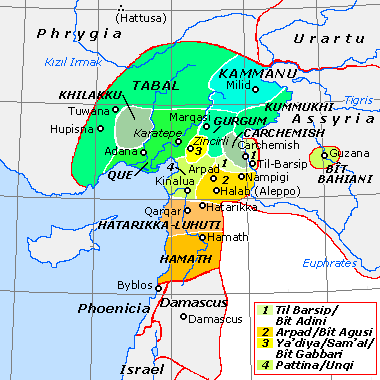Palistin
| Palistin | |||||
| Wadasatini / Padasatini | |||||
| |||||
| Capital | Kinalua | ||||
| Languages | Luwian | ||||
| Government | Absolute monarchy | ||||
| Historical era | Iron Age | ||||
| - | Established | 11th century BC | |||
| - | Disestablished | 9th century BC | |||
| Today part of | | ||||
Palistin (or Walistin), was an early Syro-Hittite located in north western Syria and Hatay, Turkey. its existence was confirmed by the discovery of several inscriptions mentioning Taita king of Palistin.
.jpg)
History
Palistin was one of the Syro-Hittite states that emerged in Syria after the Late Bronze Age collapse,[1] it dates to at least the 11th century BC and is known primarily through the inscriptions of its king Taita and his wife.[1] the kingdom wasn't established immediately after the collapse of the Hittite Empire, and it encompassed a relatively extensive area, stretching at least from the Amouq Valley in the west to Aleppo in the east down to Mhardeh and Shaizar in the south.[2] Prof. Itamar Singer propose that it was the predecessor state that disintegrated and gave birth to the kingdoms of Hamath, Bit Agusi and Pattin (shortened form of Palistin).[3]
Archaeological evidence
The excavations at Tell Tayinat in the Turkish Hatay province which might have been the capital of Palistin,[4] revealed two settlements, the first is a Bronze Age Aegean farming community, and the second is an Iron Age Syro-Hittite city built on top of the Aegean farming settlement,[3] Palistin is attested as Walistin in an inscription discovered in 1936 at the site.[5]
Palistin is also attested in the Shaizar Stele which is a funerary monument dedicated to Queen Kupapiya the wife of Taita, another stele was discovered in Mhardeh and is either dedicated to Kupapiya calling her the queen of the land, or dedicated to a goddess (probably Kubaba), the name of Taita is mentioned on both steles.[6] most importantly in 2003, a statue of King Taita bearing his inscription in Luwian was discovered during excavations conducted by German archeologist Kay Kohlmeyer in the Citadel of Aleppo.[1][7]
Name readings and biblical Philistines
Hittitologist John David Hawkins translated the Aleppo inscriptions, he gave two readings (Wadasatini and Padasatini), Palistinean is the latest reading confirmed by experts.[4] The similarity between Palistin and Philistin led Archaeologists Benjamin Sass,[8] and Kay Kohlmeyer to hypothesize a connection between the Syro-Hittite Palistin and the biblical Philistia.[9]
However Prof. Singer noted that although the name Palistin (as its read in the inscriptions of Taita discovered at Aleppo) or Wadastin (as it is read in the inscriptions at Tell Tayinat) indicate a link to the Sea People of which the Biblical Philistines belonged, there is nothing (beside the name) in the recently discovered archeology of the Syro-Hittite Tell Tayinat city, neither pictorial nor philological, that indicate an Aegean origin.[3] On the contrary, most of the discoveries at Tell Tayinat indicate a typical Luwian state; the Neo-Hittite inhabitants used predominantly red slipped burnished ware, which is totally different from the Aegean type pottery used by the early farming inhabitants;[3] the names of the kings of Palistin and the successors kings of Pattin are also Hittite,[3] although there is no evidence of a direct link between Taita and the old Hittite royal house. Singer proposed (based on archeological finds) that a branch of the Biblical Philistines did settle in Tell Tayinat, but were replaced or assimilated by new Luwian population who took the Palistin name.[3]
The reading of Palistin is still under debate,[2][9] the Shaizar and Mhardeh inscriptions preserve the ethnicon Walistin, There is no clear explanation for the alternation between WA in the Shaizar and Mhardeh inscriptions and PA in the Aleppo inscriptions.[9] According to Hittitologist Trevor Bryce, the connection between the biblical Philistines and the kingdom of Palistin remains a hypothesis and further excavations are needed to establish such a connection.[2]
Citations
- ↑ 1.0 1.1 1.2 Trevor Bryce. The World of The Neo-Hittite Kingdoms: A Political and Military History. p. 128.
- ↑ 2.0 2.1 2.2 Trevor Bryce. Ancient Syria: A Three Thousand Year History. p. 111.
- ↑ 3.0 3.1 3.2 3.3 3.4 3.5 See Before and After the Storm, Crisis Years in Anatolia and Syria between the Fall of the Hittite Empire and the Beginning of a New Era (ca. 1220-1000 BC), A Symposium in Memory of Itamar Singer, University of Pavia p. 7+8
- ↑ 4.0 4.1 Trevor Bryce. The World of The Neo-Hittite Kingdoms: A Political and Military History. p. 129.
- ↑ D. T. Potts. A Companion to the Archaeology of the Ancient Near East. p. 802.
- ↑ Annick Payne. Iron Age Hieroglyphic Luwian Inscriptions. p. 47.
- ↑ Guy Bunnens. A New Luwian Stele and the Cult of the Storm-god at Til Barsib-Masuwari. p. 130.
- ↑ Benjamin Sass, Taita, King of Palistin : CA 950-900 BCE ?, University of tel aviv, 2010
- ↑ 9.0 9.1 9.2 Ann E. Killebrew. The Philistines and Other "Sea Peoples" in Text and Archaeology. p. 662.
| ||||||||||||||||||||||||||||||||||||||||||||||||||||||||||||||||||||
